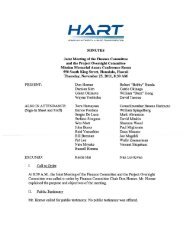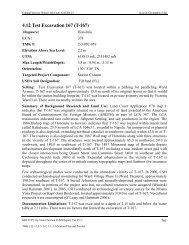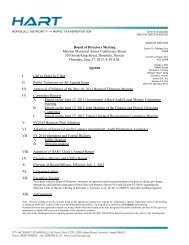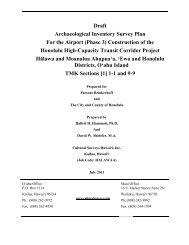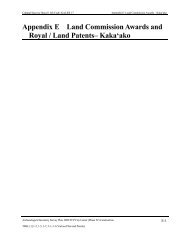AISP Kamehameha Highway Guideway - Honolulu Rail Transit Project
AISP Kamehameha Highway Guideway - Honolulu Rail Transit Project
AISP Kamehameha Highway Guideway - Honolulu Rail Transit Project
Create successful ePaper yourself
Turn your PDF publications into a flip-book with our unique Google optimized e-Paper software.
Cultural Surveys Hawai‘i Job Code: MANANA 1<br />
Background Research<br />
‘Aiea<br />
‘Aiea Ahupua‘a extends from the East Loch of Pearl Harbor to the Pu‘u ‘Ua‘u mountain peak,<br />
generally following ‘Aiea Stream. ‘Aiea is said to have been named for the ‘aiea (Nothocestrum<br />
sp.) tree or shrub (Pukui et al. 1974:7), which was used for thatching sticks and for fire-making<br />
(Pukui and Elbert 1971:9). Pu‘u ‘Ua‘u is named after the ‘ua‘u, or dark-rumped petrel<br />
(Pterodroma phaeopygia sandwichensis), a seabird that travels inland to nest (Pukui et al.<br />
1974:206). The wall of Loko Kakupōhaku, a large fishpond in ‘Aiea along the Pearl Harbor<br />
coast (see Figure 9), marked the boundary between ‘Aiea and Hālawa Ahupua‘a.<br />
Hālawa<br />
Hālawa Ahupua‘a extends from the East Loch of Pearl Harbor to the crest of the Ko‘olau<br />
Range, generally following Hālawa Stream. The word hālawa is translated as “curve” (Pukui et<br />
al. 1974:36). Along the coastal trail connecting <strong>Honolulu</strong> to Wai‘anae, ‘Īī (1959:95) mentioned<br />
two resting places in Hālawa for travelers, Napehā and Kauwamoa. Napehā, translated as “bend<br />
over breath” (Pukui et al. 1974:163), was a pool and resting place where people went diving. The<br />
pool was said to have been named for the chief, Kūali‘i, who stopped and bent over the pool to<br />
take a drink (‘Ī‘ī 1959:95). Kauwamoa was also a diving place where people liked to gather, said<br />
to be a favorite diving spot of Pe‘ape‘a, son of <strong>Kamehameha</strong>nui of Maui (‘Ī‘ī 1959:95).<br />
Kūāhua, a small offshore island considered a part of Hālawa Ahupua‘a, is translated as<br />
“standing heap” (Pukui et al. 1974:118). Kūāhua was attached to the coast via the Loko Kunana<br />
fishpond (see Figure 9). A long time resident stated the fishpond was named after Kūanānā, the<br />
mother of Ka‘ahupahau, the shark chiefess of Pu‘uloa, who liked to fish there (Sterling and<br />
Summers 1978:10). Makalapa Crater is a prominent geological feature located inland of Loko<br />
Kunana (see Figure 9). The word makalapa is translated as “ridge features” (Pukui et al.<br />
1974:140). Leilono, located on the hill of Kapukaki (Red Hill) at the boundary between Hālawa<br />
and Moanalua Ahupua‘a, “was a place said to be the opening, on the island of O‘ahu, for<br />
mankind to enter eternal night” (Kuokoa Aug. 11, 1899, cited in Sterling and Summers 1978:9).<br />
2.1.2 Traditions Associated with the ‘Ewa District<br />
Some of the themes associated with ‘Ewa include connections with Kahiki, the traditional<br />
homeland of Hawaiians in central Polynesia. There are several versions of the chief Kaha‘i<br />
leaving from Kalaeloa on a trip to Kahiki. Upon his return to the Hawaiian Islands, he brought<br />
back the first breadfruit (Kamakau 1991:110) and planted it at Pu‘uloa, near Pearl Harbor in<br />
‘Ewa (Pukui et al. 1974:200). Several stories associate places in ‘Ewa to the gods Kāne and<br />
Kanaloa, with the Hawaiian pig god Kamapua‘a and the Hina family, and with the sisters of the<br />
volcano goddess Pele, all of whom have strong connections with Kahiki (Kamakau 1991:111).<br />
‘Ewa literally translates as “crooked” (Pukui et al. 1974:28) or “imperfect” (Pukui and Elbert<br />
1971:39). Others interpret the meaning of ‘Ewa as “strayed,” in association with a story about<br />
the gods Kāne and Kanaloa, who threw a stone to determine the boundary of the district:<br />
When Kane and Kanaloa were surveying the islands they came to Oahu and when<br />
they reached Red Hill saw below them the broad plains of what is now Ewa. To<br />
mark boundaries of the land they would throw a stone and where the stone fell<br />
Archaeological Inventory Survey Plan, HHCTCP Construction Phase II, Waiawa, Mānana, Waimano, Waiau,<br />
Waimalu, Kalauao, ‘Aiea, and Hālawa Ahupua‘a, ‘Ewa District, Island of O‘ahu<br />
TMK[1] 9-7, 9-8, and 9-9 - Various Plats and Parcels<br />
22



